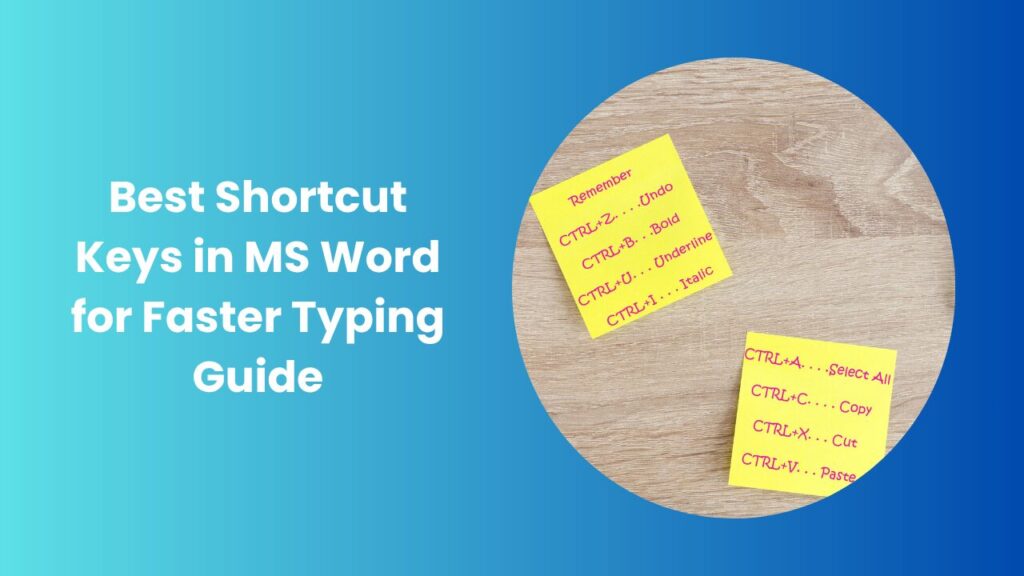In today’s fast-paced digital world, efficiency and speed are everything, especially when working on documents. Whether you are a student preparing assignments, a professional drafting reports, or a writer managing multiple projects, the ability to perform tasks quickly in Microsoft Word can make all the difference. Learning how to use shortcut ms word effectively can transform the way you work, turning a time-consuming process into a smooth and productive experience. Instead of relying on repetitive mouse clicks, mastering keyboard shortcuts allows you to control nearly every feature of Word right from your keyboard, saving time, reducing fatigue, and improving overall accuracy.
Microsoft Word, part of the Microsoft Office suite, is one of the most widely used word processors across the globe. However, many users only use its basic features, unaware that a large number of powerful functions can be accessed instantly using shortcut keys. This article explores how mastering these shortcuts can boost productivity, discusses the logic behind keyboard combinations, and provides practical ways to integrate them naturally into your daily workflow.
Understanding the Purpose of Shortcuts
The idea behind keyboard shortcuts is simple to perform frequent tasks quickly without taking your hands off the keyboard. Every command in Microsoft Word that requires a menu or toolbar action usually has a shortcut equivalent. This system not only helps users navigate faster but also reduces dependency on the mouse, which in turn improves workflow speed.
For instance, the simple combination of Ctrl + C and Ctrl + V for copying and pasting text is known even to beginners. But beyond these basics, Word offers hundreds of shortcuts that cover formatting, navigation, editing, reviewing, and layout management. Once users understand the pattern behind these key combinations, they can remember and apply them without difficulty. This muscle memory helps users stay focused on content creation rather than on searching for buttons or options.
Why Keyboard Shortcuts Matter in Word
Time efficiency is one of the biggest advantages of learning shortcuts. Over time, these seconds saved on every task add up to minutes and even hours. Using shortcuts consistently can improve your typing rhythm because your fingers remain on the keyboard. It also reduces strain on your hands and wrists since you aren’t constantly switching between keyboard and mouse.
Another major benefit is precision. Keyboard shortcuts minimize the risk of selecting the wrong options or accidentally clicking outside a text box. For professionals working on detailed documents like contracts or reports, this level of accuracy is invaluable. Moreover, shortcuts help users stay organized and focused because they encourage workflow consistency and better command recall.
Exploring the Logic Behind Word Shortcuts
Most shortcuts in Microsoft Word are designed logically. The letter in the command often corresponds to the first letter of the action. For example, Ctrl + S stands for Save, Ctrl + P for Print, Ctrl + F for Find, and Ctrl + B for Bold. This logical design helps users memorize shortcuts faster.
Beyond the simple ones, advanced shortcuts like Ctrl + Shift + N (for Normal style) or Ctrl + Alt + 1 (to apply Heading 1) can drastically speed up formatting. Many shortcuts are also customizable, allowing users to assign specific combinations for actions they use most frequently. This customization makes Word an adaptable tool that fits any workflow style.
How Shortcut Mastery Boosts Productivity
Mastering shortcut ms word means embracing a more structured and efficient way of working with documents. Instead of searching for features through ribbons or tabs, users can instantly apply actions through combinations that become second nature with practice. Imagine editing a long research paper instead of manually highlighting each section and clicking the “Bold” or “Italic” buttons; a few keystrokes can format your text instantly. Similarly, navigating between sections, inserting tables, or switching to print preview becomes a matter of seconds.
Consistency in shortcut usage also leads to faster document creation and editing. When working on large files or collaborating with others, being quick and accurate makes you more reliable and professional. Many organizations even encourage their teams to learn keyboard shortcuts as part of their workflow training because it directly increases productivity and reduces errors.
Moreover, shortcuts have accessibility benefits. For individuals who may find using a mouse physically challenging, keyboard shortcuts provide an alternative way to manage complex documents comfortably. The overall result is a more inclusive and efficient working environment where technology adapts to human needs.
The Role of Practice and Habit Formation
Learning shortcuts is not just about memorization; it’s about developing habits through repetition. In the beginning, remembering all the combinations might seem overwhelming. However, focusing on learning a few frequently used ones and gradually expanding your list makes the process easier. As you continue practicing, you will start using them automatically without conscious thought.
One effective method is to associate shortcuts with daily tasks. For example, every time you save your document, use Ctrl + S instead of clicking the save icon. Over time, these habits form naturally. This consistent approach ensures that shortcuts become an integral part of your writing routine, enhancing productivity and accuracy with minimal effort.
Enhancing Formatting and Editing Efficiency
Text Formatting Shortcuts
Formatting text manually can take considerable time, especially in long documents. However, once you master the right keyboard shortcuts, you can bold, italicize, underline, or adjust spacing in moments. Actions like aligning text, changing font sizes, or switching between styles can be performed effortlessly without interrupting your workflow.
Navigation Shortcuts for Faster Movement
Efficient navigation is another key benefit of using keyboard commands. Jumping from one section of a document to another or moving between words and paragraphs can be done instantly. This capability is especially useful for proofreading or editing large documents where scrolling manually could take minutes.
Reviewing and Commenting with Shortcuts
Microsoft Word also offers shortcuts for reviewing documents, adding comments, and tracking changes. These features make collaboration easier, especially when working in teams. Instead of clicking multiple times to add feedback, users can use shortcut keys to streamline the reviewing process, ensuring clear and fast communication.
How Shortcuts Support Professional and Academic Workflows
In professional and academic settings, time management is crucial. Reports, essays, research papers, and presentations all require formatting consistency and structure. Shortcuts not only make this process faster but also maintain document integrity. Using consistent formatting shortcuts ensures that your work looks professional every time, eliminating inconsistencies that might arise from manual adjustments.
Additionally, mastering shortcuts helps users meet deadlines efficiently. For instance, students working on multiple projects can switch between formatting styles quickly, while office professionals can compile reports or meeting notes without interruptions. The use of shortcuts thus becomes a sign of digital fluency and professionalism.
Common Mistakes When Learning Shortcuts
One common mistake new users make is trying to learn too many shortcuts at once. This can cause confusion and frustration. It is better to start small and gradually add more as you become comfortable. Another mistake is ignoring customization options. Microsoft Word allows users to modify or create new shortcuts tailored to their personal workflow a feature often overlooked.
Additionally, some users rely heavily on the mouse even after learning shortcuts. This habit slows down their progress. The best way to master shortcuts is to commit fully to keyboard-based navigation for a certain period until it becomes natural. Finally, always stay updated, as Microsoft occasionally introduces new shortcuts with software updates.
FAQs
What are shortcuts in Microsoft Word?
Shortcuts in Microsoft Word are specific key combinations that perform commands instantly without requiring mouse actions. They simplify document editing, formatting, and navigation tasks, allowing users to work faster and more efficiently.
Are Word shortcuts the same for Windows and Mac?
While most shortcuts are similar, some differ depending on the operating system. For example, Windows uses the “Ctrl” key, whereas Mac replaces it with the “Command” key for similar functions. However, the overall logic behind shortcuts remains consistent across platforms.
Can I customize my own shortcuts in Word?
Yes, Microsoft Word allows users to assign custom shortcut keys to almost any command. This can be done through the “Customize Keyboard” options in the settings menu. Personalizing shortcuts ensures that your workflow is optimized to your preferences.
How can I remember multiple shortcuts easily?
The best approach is gradual learning and consistent usage. Start with a few essential shortcuts you use daily and repeat them until they become instinctive. You can also print a small shortcut reference and keep it near your workspace for quick reminders.
Do shortcuts improve document formatting consistency?
Absolutely. Shortcuts eliminate manual variation, ensuring consistent formatting across your document. For example, using the same combination for applying headings or bullet points maintains uniformity, which is especially valuable in professional or academic writing.
Are shortcuts beneficial for accessibility?
Yes, shortcuts are a vital tool for accessibility. They allow individuals who have difficulty using a mouse to perform all necessary tasks via the keyboard. Microsoft continuously improves accessibility features to ensure inclusivity for all users.
Conclusion
Mastering shortcut ms word is more than just learning key combinations; it’s about building efficiency, accuracy, and confidence in document creation. Once you integrate shortcuts into your daily workflow, you will notice significant improvements in speed and focus. They allow you to interact with Microsoft Word more intelligently, keeping your attention on writing and creativity instead of repetitive actions.
Ultimately, keyboard shortcuts are not just tools for convenience; they are a gateway to mastering digital productivity. By committing to learning them, practicing regularly, and customizing your experience, you transform Microsoft Word into a seamless, powerful extension of your own skillset that supports both creativity and professional precision.





